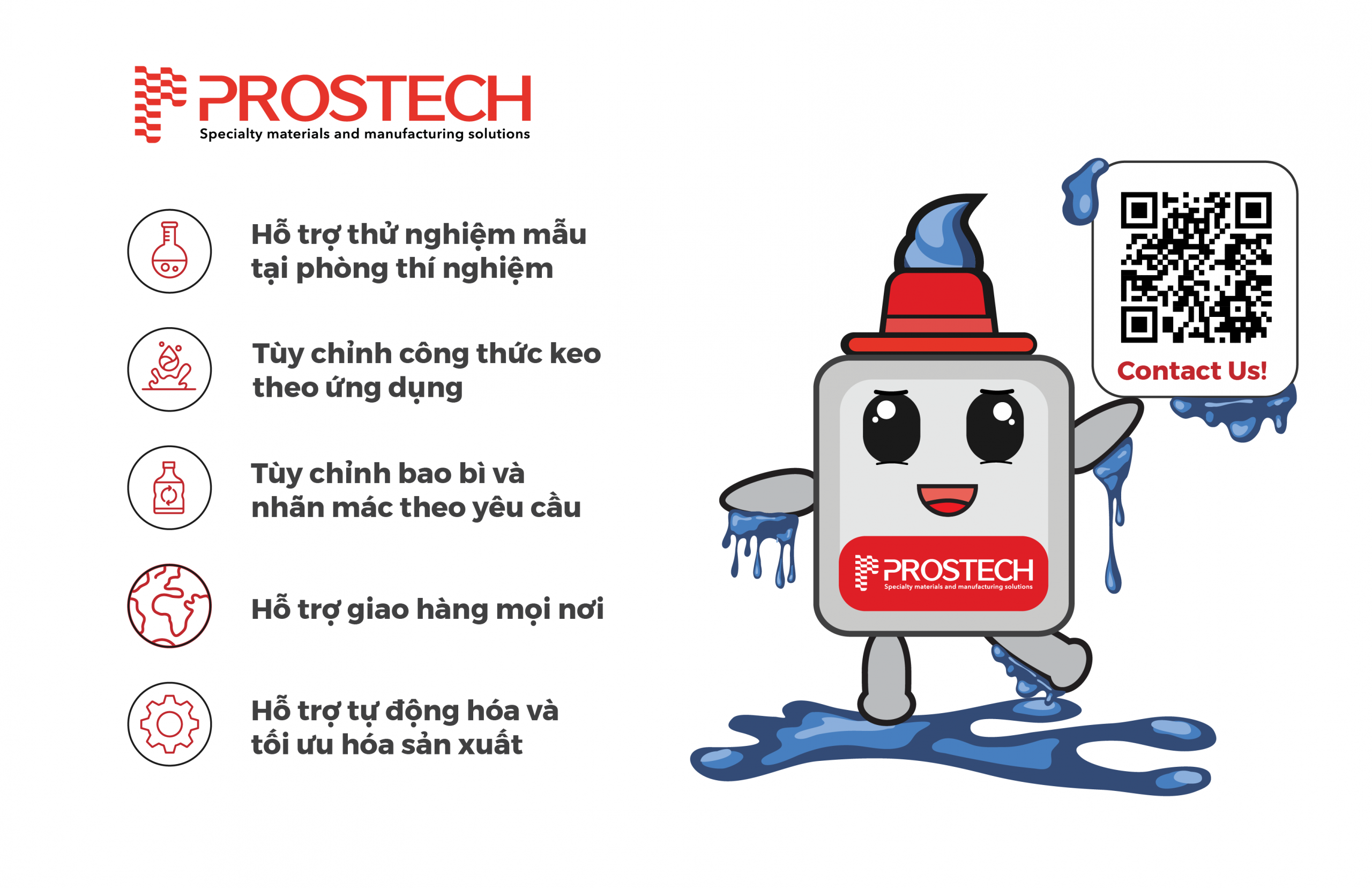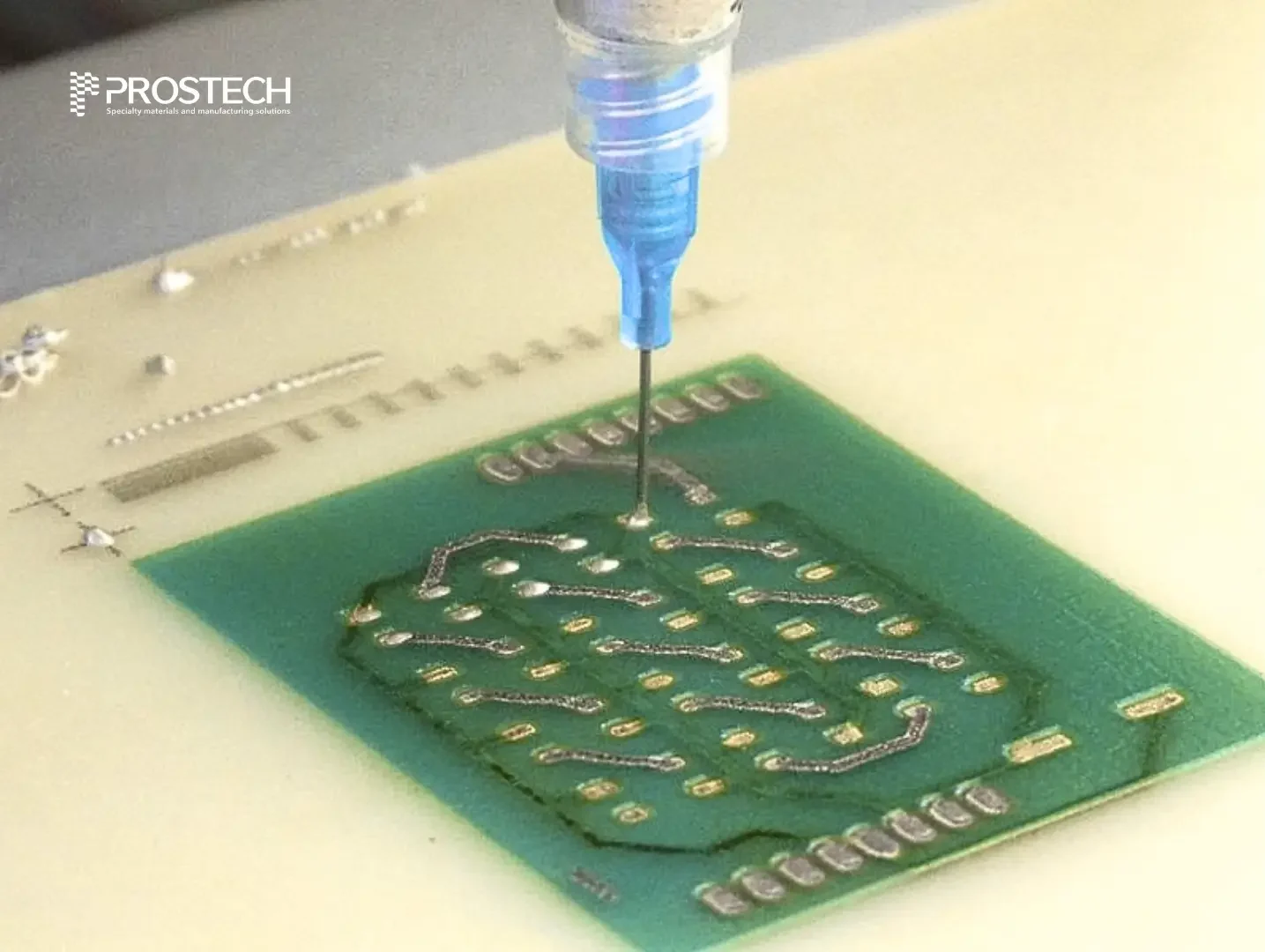Nhựa (plastic) là loại vật liệu không thể thiếu trong cuộc sống hằng ngày. Không chỉ các sản phẩm được chế tạo thuần túy từ nhựa, các sản phẩm chế tạo từ kim loại trong nhiều trường hợp còn được phủ lên một lớp nhựa để tăng độ thẩm mỹ, độ bền và hiệu suất sử dụng. Một số ngành sản xuất sử dụng keo dán nhựa phổ biến có thể kể đến như Sản xuất phương tiện giao thông, thiết bị y tế, Thiết bị điện tử, Điện tử dân dụng, Năng lượng, Dụng cụ thể thao,…
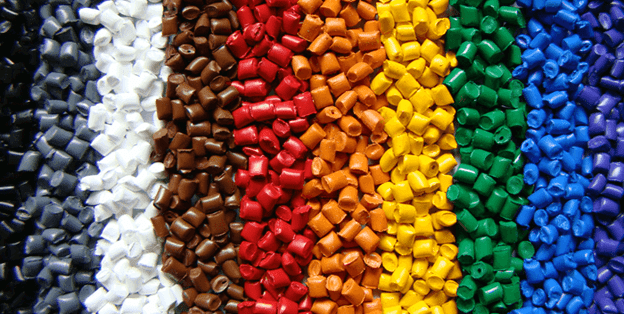
Không thể phủ nhận những giá trị mà vật liệu nhựa mang lại. Nhưng chúng ta cần thừa nhận loại vật liệu này đã mang đến nhiều khó khăn trong quá trình thiết kế và lựa chọn vật liệu kết dính, lắp ráp chúng. Trên thị trường có nhiều loại keo dán và đa dạng loại bề mặt nhựa. Vậy làm sao để lựa chọn đúng loại keo cho đúng loại nhựa mà vẫn đạt được hiệu quả? Bài viết này sẽ giải đáp cho bạn lý do tại sao nhựa khó dán, cách để thiết kế mối dán nhựa và gợi ý một số loại keo dán nhựa hiệu quả cao.
Tại sao nhựa lại khó dán?
Các loại nhựa như polyethylene, polypropylene và polytetrafluoroethylene (PTFE) là một trong những loại nhựa khá khó dán bởi bề mặt năng lượng của chúng khá thấp, chỉ vào khoảng 20 đến 40 dynes. Polyolefin và Teflon là hai vật liệu nhựa phổ biến nhất, có polymer với các đặc tính độc và ứng dụng riêng biệt. Các loại nhựa này đều được sử dụng rộng rãi trong sản xuất công nghiệp.
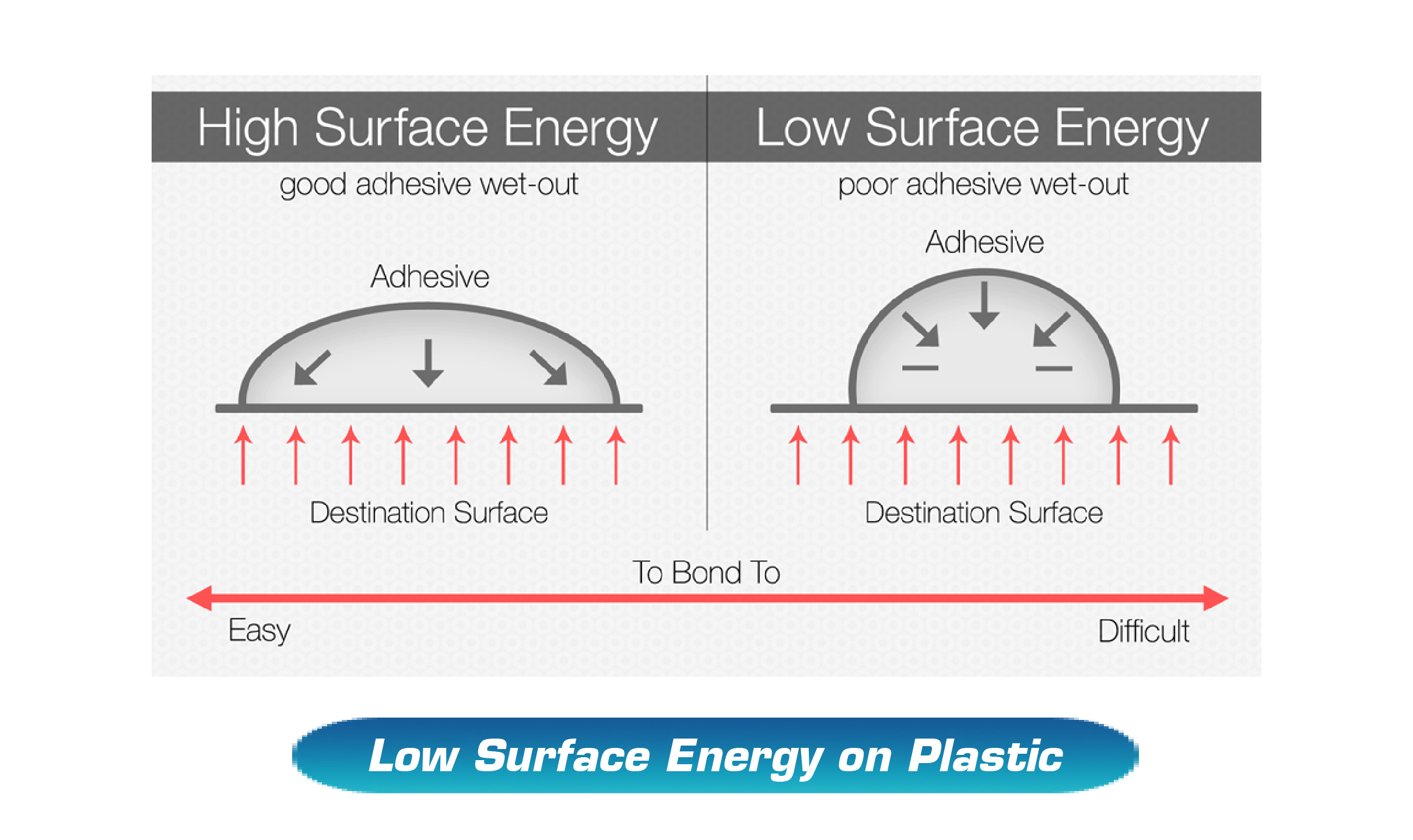
Đặc Tính Của PTFE
PTFE, hay polytetrafluoroethylene, là một loại polyme được gọi là nhựa perfluorocarbon. Cụ thể, trong nhựa perfluorocarbon, tất cả các nguyên tử carbon trong mạch chính của chuỗi polymer được liên kết hoàn toàn với các nguyên tử flo. Liên kết carbon và flo (liên kết C-F) là một liên kết mạnh đến mức cả oxy và tia cực tím đều không đủ năng lượng để phá vỡ nó. Do đó, sức mạnh của liên kết này là nguồn gốc của tính trơ hóa học và đặc tính lão hóa tốt.
Đồng thời, sự phân bố của nguyên tử flo xung quanh khung polyme carbon giúp cân bằng điện tích âm và điện dương, làm cho PTFE không phân cực. Vì vậy, các vật liệu không phân cực không hấp dẫn các chất phân cực, như nước. Polyme flo hóa hoàn toàn này có năng lượng bề mặt thấp, dẫn đến việc nó không thể bị ướt bởi nước. PTFE không có chất hòa tan nào được biết đến

Chemical structure of PTFE
Khó Khăn Khi Dán Teflon
Ngoài ra, Teflon cũng có khả năng chống chịu hóa chất tốt và có độ bền nhiệt cao, điều này làm cho nó trở thành vật liệu lý tưởng trong nhiều ứng dụng như ống dẫn chất lỏng, chảo chống dính và các ứng dụng y tế. Tuy nhiên, đặc tính không bám dính của Teflon cũng gây khó khăn trong việc dán nó với các vật liệu khác. Quy trình này đòi hỏi các phương pháp chuẩn bị bề mặt và keo chuyên biệt để đảm bảo độ dính tốt.
Một số Vật Liệu Y Tế Khó Dính
Trong lắp ráp thiết bị y tế, các loại vật liệu như Nylon, COC/COP (cyclic olefin copolymer/polymer) và PEBA (polyether block amide) được ưa chuộng vì các đặc tính ưu việt và khả năng đáp ứng các yêu cầu nghiêm ngặt của ngành y tế. Tuy nhiên, cấu trúc hóa học của những vật liệu này lại làm cho chúng có năng lượng bề mặt thấp, từ đó đặt ra những thách thức khi kết dính chúng lại với nhau. Do đó, bạn có thể tham khảo bài viết Làm thế nào để liên kết các vật liệu khó dính (Nylon, COC/COP và PEBA) trong lắp ráp thiết bị y tế? để tìm hiểu về keo dán nhựa cho y tế và các chứng chỉ yêu cầu.
Bên cạnh các loại nhựa thường thấy, vật liệu composite hay nhựa tổng hợp cũng mang đến nhiều khó khăn cho nhà sản xuất vì sự khác biệt về năng lượng bề mặt và khả năng thấm ướt giữa các loại nhựa trong hợp chất. Vì vậy, Prostech đã gợi ý một số loại keo dán cho vật liệu nhựa tổng hợp Composite trong bài viết này. Bạn có thể click vào đây để đọc toàn bộ bài viết.
Giải Pháp Cho Bề Mặt Khó Dính
Các chất bẩn như bụi, dầu nhớt, dấu vân tay,… bị để lại do quá trình cắt dũa trước đó cũng là một vấn đề cần quan tâm. Nếu nhà sản xuất không loại bỏ các lớp chất bẩn này trước khi kết dính thì keo dán thực chất chỉ liên kết với lớp bụi bẩn này chứ không phải bề mặt nhựa thực sự.
Tựu chung lại, nguyên nhân khiến bề mặt nhựa khó dán là do năng lượng bề mặt của nhựa thấp và do các lớp bụi bẩn, dầu nhớt trên bề mặt chưa được làm sạch. Để giải quyết vấn đề trên, trước khi dán nhựa, ta cần xử lý bề mặt nhựa, hay làm sạch bề mặt nhựa trước khi dán, đọc bài viết về phương pháp xử lý bề mặt của Prostech tại đây.
Các Phương Pháp Xử Lý Bề Mặt
- Plasma: Xử lý bề mặt, tăng, giảm năng lượng bề mặt bằng tia Plasma, không sử dụng hóa chất.
- Làm sạch bằng hóa chất: Sử dụng dung môi để làm sạch bề mặt hoàn toàn, hãy cân nhắc đến các yếu tố môi trường, chống cháy, sức khỏe khi lựa chọn dung môi phù hợp.
Liên hệ Prostech để lựa chọn giải pháp xử lý bề mặt nhựa khó dán cho sản phẩm của bạn.
Các bước lựa chọn keo dán nhựa hiệu quả.
1. Xác định bề mặt nhựa cần kết dính
Bề mặt thực sự cần kết dính là nhựa?
Có nhiều nhà sản xuất đã phủ sơn tĩnh điện lên bề mặt nhựa cho các thiết bị của họ. Lúc này, bề mặt sơn tĩnh điện mới là bề mặt tiếp xúc trực tiếp với keo, không phải loại nhựa cấu tạo nên chúng. Với sơn tĩnh điện, chúng ta cần có các bước xử lý chúng trước khi kết dính.
Bề mặt cần kết dính là loại nhựa nào?
Mỗi loại nhựa có đặt tính khác nhau. Việc xác định rõ loại nhựa sẽ giúp bạn lựa chọn được đúng loại keo phù hợp. Bề mặt của bạn là loại nhựa nào trong các loại nhựa thông dụng (PET, HDPE, PVC, LDPE, PP, ABS, Polyolefin, Teflon,…)? Nếu không phải các loại này, thì là loại nhựa gì? Hãy xác định rõ để không mất thời gian tìm kiếm keo dán nhựa phù hợp.
2. Bước xử lý bề mặt nhựa
Như đã được nhắc đến ở phía trên, trước khi bộ phận nhựa đến với bước lắp ráp, nó đã trải qua nhiều bước gia công. Trong quá trình này, nhiều loại dung môi và hóa chất khác như dầu, nhớt, chất tháo khuôn, bụi bẩn đã bám lên bề mặt. Những chất này nằm giữa vị trí tiếp xúc giữa bề mặt nhựa với keo, do đó, dẫn đến bề mặt tiếp xúc bị thu hẹp và mối nối bị yếu đi.
Vì vậy, nhà sản xuất cần phải xử lý bề mặt nhựa trước khi kết dính. Một trong các phương pháp làm sạch là sử dụng dung môi hoặc hóa chất tẩy rửa để loại bỏ các lớp bụi bẩn nhìn thấy hoặc không nhìn thấy bằng mắt thường. Tuy nhiên, phương pháp này chỉ làm sạch bề mặt chứ không làm thay đổi năng lượng bề mặt.
Để tối đa hóa khả năng kết dính của bề mặt nhựa, nhà sản xuất có thể tham khảo công nghệ xử lý bề mặt PLASMA.
Hoặc, liên hệ với chúng tôi để nhận tư vấn quy trình xử lý bề mặt chuyên sâu dành cho các vật liệu nhựa khó dán.
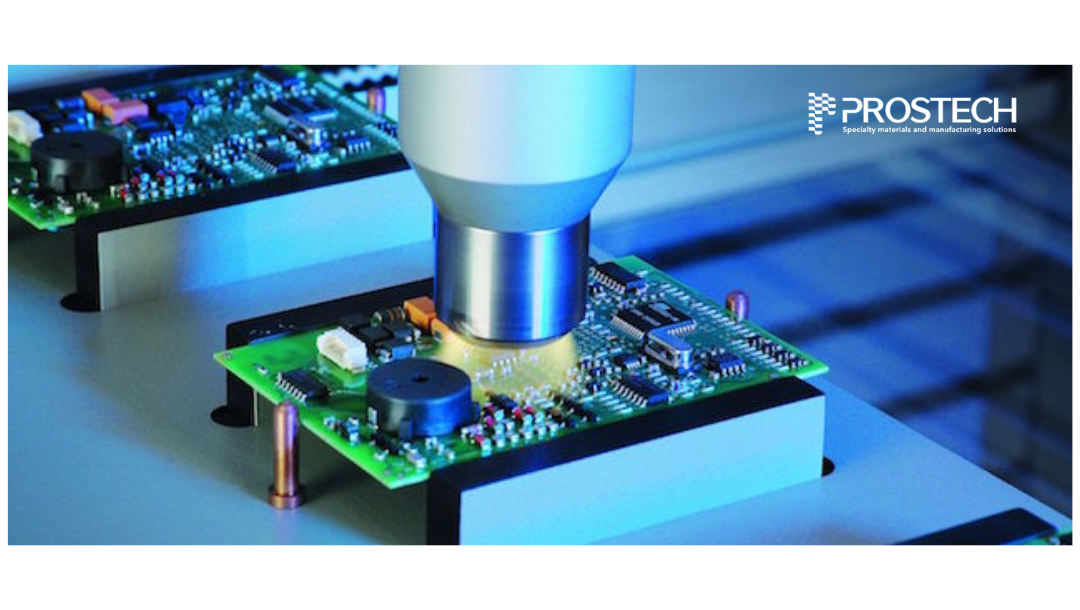
Tuy nhiên, nếu bề mặt nhựa không phải loại nhựa khó dán, thì bạn chỉ cần lựa chọn được loại keo phù hợp là đã có thể đem đến một mối kết dính chắc chắn. Chúng tôi có gợi ý một số loại keo dán nhựa trong mục 4. Lựa chọn keo dán nhựa phù hợp.
3. Thiết kế mối dán cho bề mặt nhựa
Lực tác động vào mối dán nhựa là yếu tố quan trọng, cần được cân nhắc khi thiết kế mối dán. Các kỹ sư cần có một nền tảng kiến thức chắc chắn về việc phân bổ lực giữa hai bề mặt để có thể thiết kế được một mối dán chắc chắn nhất có thể.

Có 5 lực tác động mà mối dán phải chịu đựng khi hai bề mặt kết dính với nhau bằng keo dán/ băng dính, đó là:
- Shear Strength (Độ bền cắt)
- Compression Strength (Độ bền nén)
- Tension Strength (Độ bền kéo)
- Cleavage Strength (Độ bền cắt ngang)
- Peel Strength (Độ bền bóc)
Hầu hết các chất kết dính đều có Độ bền cắt, Độ bền nén, và Độ bền kéo. Nhưng hiệu suất sẽ giảm dần khi phải chịu đựng Lực cắt ngang và Lực bóc theo thời gian. Để có thể thiết kế được mối dán bền chặt nhất, phân bổ lực phải đều trên cả bề mặt được kết dính.
Prostech có nhiều năm kinh nghiệm trong thiết kế mối dán phù hợp với đa dạng các loại vật liệu và bề mặt, đặc biệt là bề mặt nhựa, hãy liên hệ với chúng tôi để nhận tư vấn.
4. Lựa chọn loại keo dán nhựa phù hợp
Khi lựa chọn keo dán, điều quan trọng là phải nắm rõ được đặc điểm của từng loại keo. Bởi vì các tính chất này có thể tác động trực tiếp đến thời gian sản xuất, khả năng chống chịu với nhiệt độ, độ ẩm, hóa chất và các động khác đến từ bên ngoài lên mối dán.
Keo CA, keo UV, Acrylic hay các loại keo cường lực khác đều có thể sử dụng để dán nhựa. Tuy nhiên, có nhiều sự lựa chọn như vậy lại gây khó khăn cho người sử dụng. Đâu mới là loại keo phù hợp nhất?
a, Keo CA (Keo cyanoacrylate) dán nhựa
Keo cyanoacrylate, còn được gọi là keo siêu dính, có một thành phần. Chúng có khả năng khô nhanh và bám dính tốt trên bề mặt nhựa.
Keo CA của PROSTECH phù hợp với hầu hết các bề mặt nhựa được làm từ ABS (acrylonitrile butadiene styrene), PMMA (acrylic), Nylon, Phenolic, Polyamide, Polycarbonate, PVC (ở cả dạng cứng và dẻo. Đối với keo dán nhanh CA, mối kết dính sẽ rất bền chắc trên cả polyethylene và polypropylene nếu sử dụng cùng với chất lót primer POP.
Một số đặc điểm nổi bật của keo dán nhựa CA của Prostech:
- Giá thành tốt
- Dễ sử dụng
- Ít hoặc không có khói trắng
- Khô nhanh, chỉ trong vài giây
- Chịu được nhiệt độ cao và hóa chất tốt
- An toàn cho người sử dụng.
- Chứng chỉ: ISO 9001, ISO 14001, UL, NSF International, REACH, RoHS,…
Tìm hiểu các ứng dụng của keo CA trong các ngành sản xuất:
Keo Cyanoacrylate Adhesives trong gắn ống thông y tế
Keo cyanoacrylate trong ngành công nghiệp sản xuất giầy dép

Xem chi tiết thông tin sản phẩm keo CA dán nhựa:
- Permabond 825 dán nhựa
- GLUDITEC CA51D-401 dán nhựa
- Loctite 406 dán nhựa
- HB Fuller M5 100 dán nhựa
- 3M CA100 dán nhựa
b, KEO UV dán nhựa
PROSTECH cung cấp các loại keo UV hiệu quả cho việc dán nhựa, đặc biệt tốt trên bề mặt ABS, Nylon, Phenolic, Polyamide, Polycarbonate, PVC và nhựa acrylic.
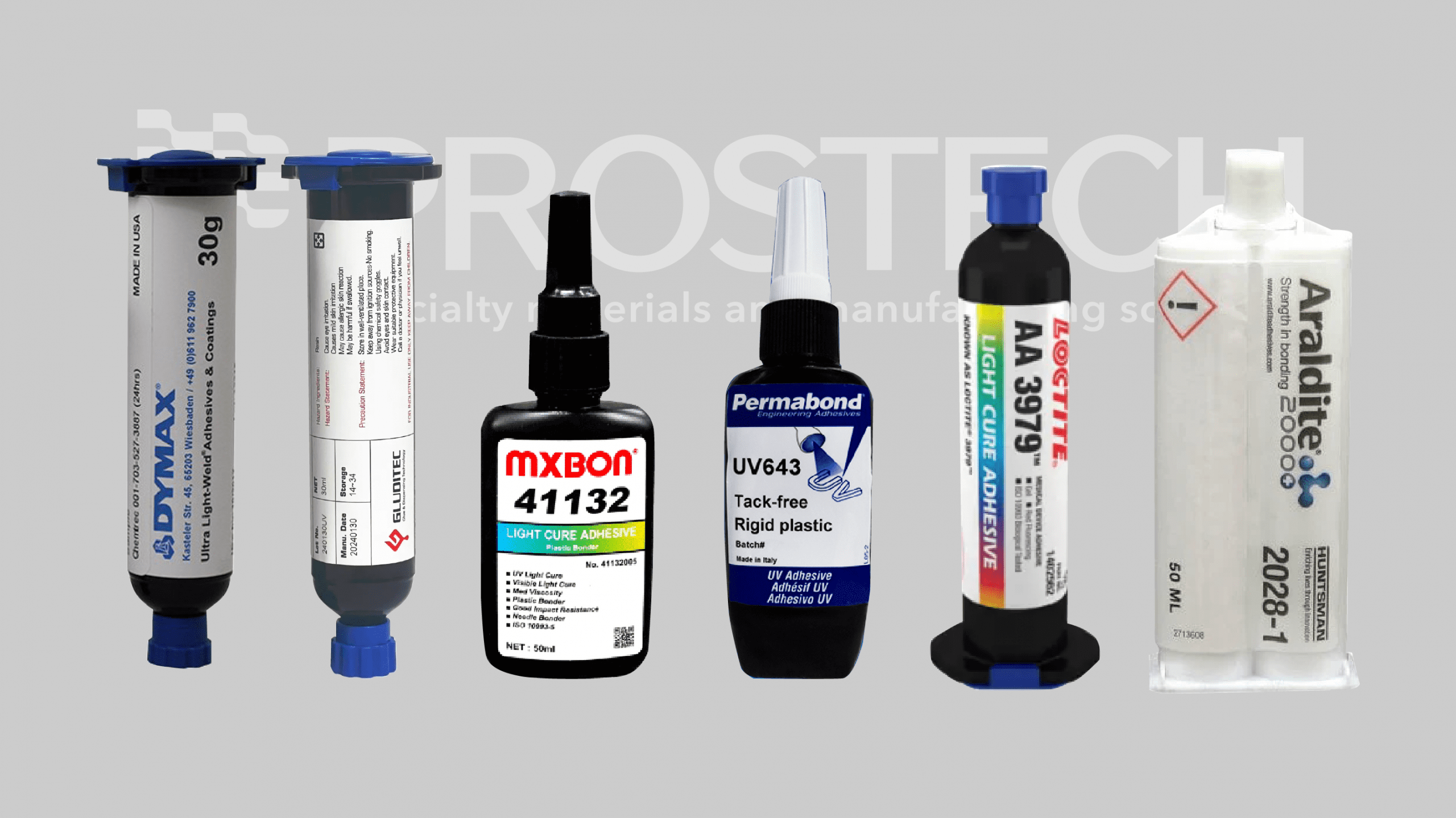
Đặc điểm nổi bật của keo UV dán nhựa Prostech:
- Khô nhanh: Keo khô trong vài giây khi chiếu tia UV, tăng tốc độ sản xuất.
- Ít hoặc không chứa dung môi VOCs.
- Khô theo yêu cầu: Chỉ khô dưới đèn UV, không phụ thuộc vào thời gian, nhiệt độ hay môi trường.
- Độ bám dính cao: Keo UV bám dính tốt trên nhựa, kim loại, thủy tinh và gốm.
- Chịu được nhiệt độ, hóa chất và tia UV: Phù hợp cho các ứng dụng đòi hỏi độ bền cao hoặc sử dụng ngoài trời.
- Dễ sử dụng: Keo UV dạng lỏng hoặc gel, dễ bôi lên bề mặt cần dán.
Để sử dụng keo UV, cần có nguồn ánh sáng UV để kích hoạt quá trình polymer hóa, thường sử dụng đèn UV hoặc lò sấy UV. Prostech cung cấp các giải pháp keo dán toàn diện, bao gồm: máy sấy UV điểm, máy sấy UV chùm, và máy sấy tích hợp băng tải.
Xem chi tiết thông tin sản phẩm keo UV dán nhựa:
Đọc thêm:
Ứng dụng của Keo UV trong Ngành Điện tử
Hạn chế của Keo UV và các giải pháp cải thiện
c, Keo Epoxy một thành phần
Keo Epoxy một thành phần thường được làm khô ở nhiệt độ sấy khá cao. Vậy nên loại keo này không phù hợp để dán các loại nhựa. Thông thường, chúng sẽ được sử dụng cho các loại nhựa chống chịu nhiệt độ tốt hoặc nhựa tổng hợp như PEEK hoặc PBT.
d, Keo Epoxy hai thành phần dán nhựa
Keo Epoxy hai thành phần thường được sử dụng để dán một số loại nhựa nhất định. Dòng sản phẩm epoxy đặc biệt của PROSTECH có đủ sức mạnh kết dính cho những ứng dụng yêu cầu độ bền cao và chống va đập từ bên ngoài.
Ngoài ra, còn có dòng keo epoxy tái cấu trúc thường được sử dụng trong ứng dụng yêu cầu cao. Loại keo này có sức mạnh kết dính và độ đàn hồi tốt hơn so với loại keo epoxy truyền thống.
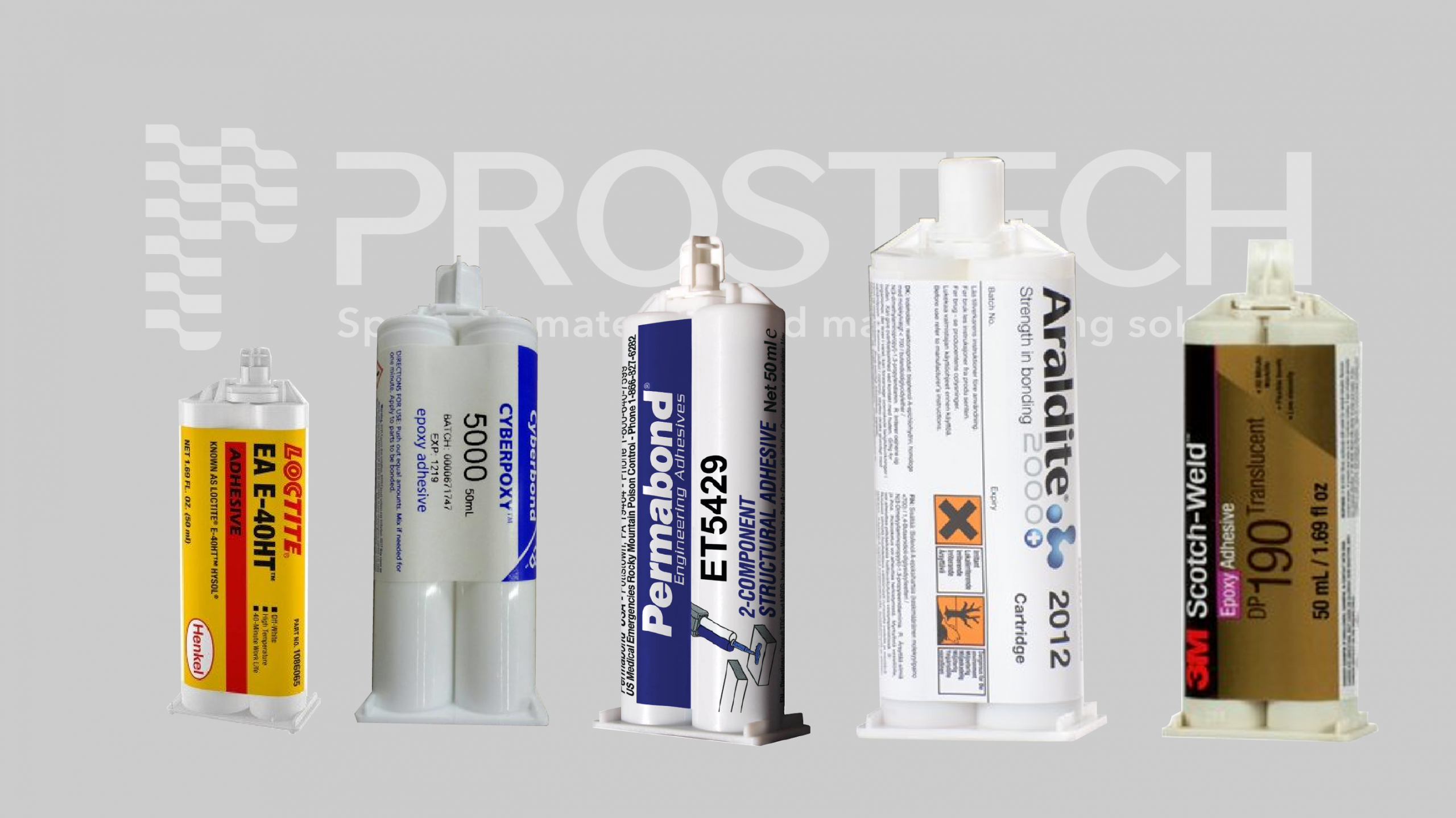
Đặc điểm của các loại keo Epoxy hai thành phần dán nhựa của Prostech:
- Độ bám dính cực cao, chịu được tải trọng nặng
- Chịu được nhiệt độ cao (từ -60°C đến +204°C)
- Chịu được hóa chất và dung môi
- Thích hợp dán kim loại, nhựa, gốm sứ và gỗ
- Chống nước
Xem thông tin chi tiết sản phẩm:
e, Keo dán cường lực MMA/ keo dán cấu trúc acrylic
Keo Acrylic là loại keo dán được trên hầu hết các bề mặt nhựa.
Keo cường lực MMAs (methyl methacrylate) chúng có khả năng kết dính tuyệt vời, đem lại mối dán bền chặt, chịu được các lựa tác động từ bên ngoài, chống chịu môi trường khắc nghiệt. Đặc biệt, chúng có thể kết dính hầu hết các bề mặt, bao gồm các loại nhựa khó dính.
Để tìm hiểu thêm về khả năng kết dính tuyệt vời của keo cường lực trong công nghiệp, hãy tham khảo bài viết này của chúng tôi.
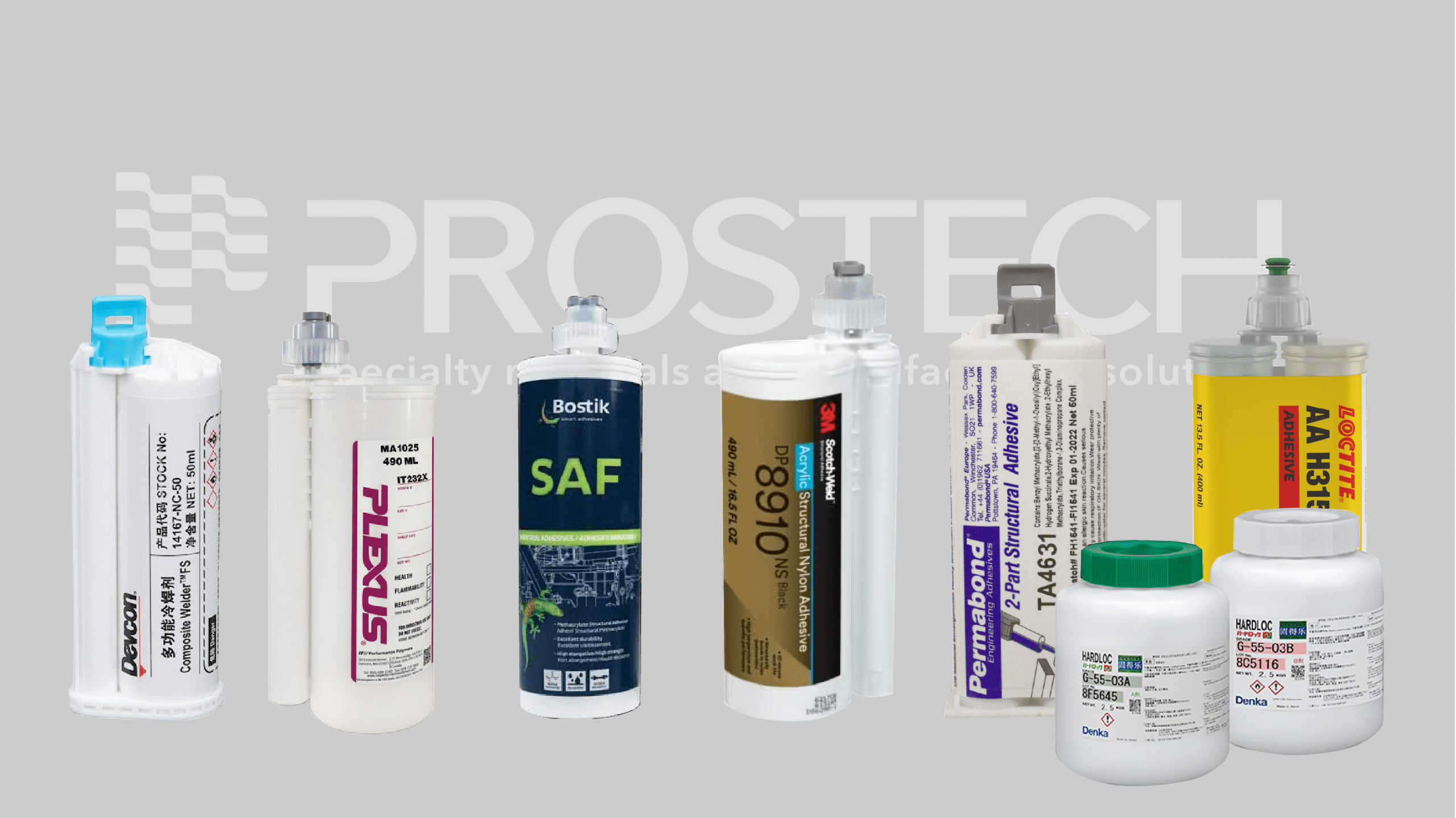
Đặc điểm chính của keo dán kết cấu MMA / keo dán acrylic:
-
Độ bám dính cao: Loại keo này tạo ra mối liên kết chắc chắn giữa các bề mặt nhựa, đảm bảo kết nối an toàn và bền vững.
-
Tính linh hoạt: Chúng có thể bám dính trên nhiều loại nhựa khác nhau, bao gồm ABS, PVC, polycarbonate và acrylic.
-
Đóng rắn nhanh: Keo Acrylic đóng rắn nhanh ở nhiệt độ phòng, giúp giảm đáng kể thời gian dán.
-
Kháng hóa chất tốt: Chúng có khả năng chống lại hóa chất, dung môi và độ ẩm, phù hợp sử dụng trong môi trường khắc nghiệt.
Xem thông tin các sản phẩm keo cường lực dán nhựa:
- LOCTITE® AA H3151 dán nhựa
- 3M™ Scotch-Weld™ DP8910NS dán nhựa
- Devcon Composite Welder FS dán nhựa
- HARDLOC G-53-03 – 2K Acrylic Adhesive dán nhựa
- Plexus® MA1025 dán nhựa
- Bostik SAF Ultimate M25 dán nhựa
- PERMABOND® TA4631 dán nhựa
Kết luận
